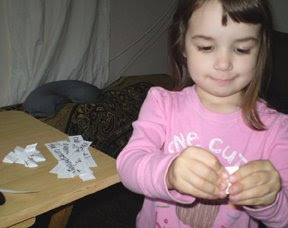Facts about me and books
I was tagged for this by Leah from The Octogon. It took me a while to think of answers, as I did a similar meme a while back; and I\’m not sure they\’ve very random, but here you go:
– My father used to say that I ought to run a used bookstore. This back in high school when half of one wall in my bedroom was just books. I always thought in return: why? I want to keep my books, not sell them. But now I do so much online swapping, constantly wrapping books to ship, I almost feel like I am.
– Every year or so I rearrange all the books on my shelves. Sometimes I want to see everything an author has written side by side (fiction and non-), other times I like the books to be organized by subject (even down to what kind of fantasy it is). Right now the books are just split into three groups: nonfic by subject, children\’s fiction by title (I\’m going through them with my daughter) and all the rest of the fiction by author.
– I never know what to do when someone gives me a book I already own. I love getting books, but this makes me feel awkward. I have duplicate copies of several books in my collection because someone gave me a lovely new copy, but for various reasons I want to hold onto the old ones as well.
– I don\’t use bookmarks anymore. I used to have a little collection, but I\’ve lost them all. When I started taking notes about my reading I\’d have a bookmark and a piece of notepaper floating around to jot things on. So I started just keeping the notepaper in the book instead of bookmarks.
– I have a huge scrap file of pictures from magazines, that I collected back when I wanted to be a children\’s book illustrator. I thought it would be useful: what if one day I needed to know what sailboat rigging looked like, or an exotic costume, or a hummingbird in flight? (this before internet was at my fingertips). Now I just use the scrap file occasionally to make custom book jacket covers, and I\’ve been thinking lately of making booksmarks. But then I don\’t know what I\’d do with them!
– I always have the intention of keeping business cards from all the used bookstores I visit, especially those I know I probably won\’t be to again (on travels). But then I forget, or loose them, or feel like it would be an incomplete collection since I haven\’t always done it. So I hardly have any. Silly.
– I have, however, saved every public library card. Except for the one I used the longest- from the King County Public Library system, where I grew up in Seattle. I don\’t know what happened to that one. Here\’s all the rest, indicating other places I\’ve lived: Madison County (Rexburg, ID); San Francisco; Sonoma County (Petaluma, CA); Baltimore, MD; Fairfax, VA and currently, Loudon County (Sterling, VA). I could easily describe all the library branches I used in these various systems, their different policies and programs, layout of the bookshelves, which new books I discovered there, etc- but that\’s for another post someday.

The rules of this meme are pretty standard: link to who tagged you, post the rules, share seven random facts about yourself (bookish, in this case), tag seven new people and give links to their blogs, visit the people you\’ve tagged and leave them a comment to tell them about it.
I\’m tagging Raych of books i done read, Trish the Hey, Lady! Whatcha Readin\’?, Petunia of Educating Petunia, Jessica at Both Eyes Book Blog, Chris of Stuff as Dreams are Made On, Steph who writes The Kea and the Literary Wombat. And anyone else who wants to just join in.












